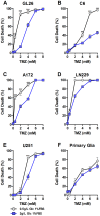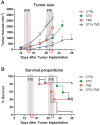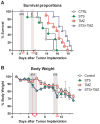Fasting enhances the response of glioma to chemo- and radiotherapy
- PMID: 22984531
- PMCID: PMC3439413
- DOI: 10.1371/journal.pone.0044603
Fasting enhances the response of glioma to chemo- and radiotherapy
Abstract
Background: Glioma, including anaplastic astrocytoma and glioblastoma multiforme (GBM) are among the most commonly diagnosed malignant adult brain tumors. GBM is a highly invasive and angiogenic tumor, resulting in a 12 to 15 months median survival. The treatment of GBM is multimodal and includes surgical resection, followed by adjuvant radio-and chemotherapy. We have previously reported that short-term starvation (STS) enhances the therapeutic index of chemo-treatments by differentially protecting normal cells against and/or sensitizing tumor cells to chemotoxicity.
Methodology and principal findings: To test the effect of starvation on glioma cells in vitro, we treated primary mouse glia, murine GL26, rat C6 and human U251, LN229 and A172 glioma cells with Temozolomide in ad lib and STS mimicking conditions. In vivo, mice with subcutaneous or intracranial models of GL26 glioma were starved for 48 hours prior to radio- or chemotherapy and the effects on tumor progression and survival were measured. Starvation-mimicking conditions sensitized murine, rat and human glioma cells, but not primary mixed glia, to chemotherapy. In vivo, starvation for 48 hours, which causes a significant reduction in blood glucose and circulating insulin-like growth factor 1 (IGF-1) levels, sensitized both subcutaneous and intracranial glioma models to radio-and chemotherapy.
Conclusion: Starvation-induced cancer sensitization to radio- or chemotherapy leads to extended survival in the in vivo glioma models tested. These results indicate that fasting and fasting-mimicking interventions could enhance the efficacy of existing cancer treatments against aggressive glioma in patients.
Conflict of interest statement
Figures





Similar articles
-
Phase II trial of continuous dose-intense temozolomide in recurrent malignant glioma: RESCUE study.J Clin Oncol. 2010 Apr 20;28(12):2051-7. doi: 10.1200/JCO.2009.26.5520. Epub 2010 Mar 22. J Clin Oncol. 2010. PMID: 20308655 Clinical Trial.
-
Temozolomide with radiation therapy in high grade brain gliomas: pharmaceuticals considerations and efficacy; a review article.Molecules. 2009 Apr 16;14(4):1561-77. doi: 10.3390/molecules14041561. Molecules. 2009. PMID: 19384285 Free PMC article. Review.
-
Epidermal growth factor receptor serum levels and prognostic value in malignant gliomas.Tumori. 2007 May-Jun;93(3):275-80. doi: 10.1177/030089160709300308. Tumori. 2007. PMID: 17679463
-
Trans-sodium crocetinate enhancing survival and glioma response on magnetic resonance imaging to radiation and temozolomide.J Neurosurg. 2010 Aug;113(2):234-9. doi: 10.3171/2009.11.JNS091314. J Neurosurg. 2010. PMID: 20001586
-
Temozolomide and treatment of malignant glioma.Clin Cancer Res. 2000 Jul;6(7):2585-97. Clin Cancer Res. 2000. PMID: 10914698 Review.
Cited by
-
Fasting potentiates the anticancer activity of tyrosine kinase inhibitors by strengthening MAPK signaling inhibition.Oncotarget. 2015 May 20;6(14):11820-32. doi: 10.18632/oncotarget.3689. Oncotarget. 2015. PMID: 25909220 Free PMC article.
-
Metabolic Reprogramming by Reduced Calorie Intake or Pharmacological Caloric Restriction Mimetics for Improved Cancer Immunotherapy.Cancers (Basel). 2021 Mar 12;13(6):1260. doi: 10.3390/cancers13061260. Cancers (Basel). 2021. PMID: 33809187 Free PMC article. Review.
-
Pushing the Limits of Cancer Therapy: The Nutrient Game.Front Oncol. 2018 May 8;8:148. doi: 10.3389/fonc.2018.00148. eCollection 2018. Front Oncol. 2018. PMID: 29868472 Free PMC article.
-
Fasting plus tyrosine kinase inhibitors in cancer.Aging (Albany NY). 2015 Dec;7(12):1026-7. doi: 10.18632/aging.100857. Aging (Albany NY). 2015. PMID: 26645151 Free PMC article. No abstract available.
-
GLUT3 enhances chemosensitivity in glioblastoma by transporting temozolomide and capecitabine.Cell Death Discov. 2025 Aug 14;11(1):382. doi: 10.1038/s41420-025-02664-w. Cell Death Discov. 2025. PMID: 40813374 Free PMC article.
References
-
- Ohgaki H, Kleihues P (2005) Epidemiology and etiology of gliomas. Acta Neuropathol 109: 93–108. - PubMed
-
- Stupp R, Mason WP, van den Bent MJ, Weller M, Fisher B, et al. (2005) Radiotherapy plus concomitant and adjuvant temozolomide for glioblastoma. N Engl J Med 352: 987–996. - PubMed
-
- Stupp R, Dietrich PY, Ostermann Kraljevic S, Pica A, Maillard I, et al. (2002) Promising survival for patients with newly diagnosed glioblastoma multiforme treated with concomitant radiation plus temozolomide followed by adjuvant temozolomide. J Clin Oncol 20: 1375–1382. - PubMed
Publication types
MeSH terms
Substances
Grants and funding
LinkOut - more resources
Full Text Sources
Other Literature Sources
Medical
Miscellaneous

